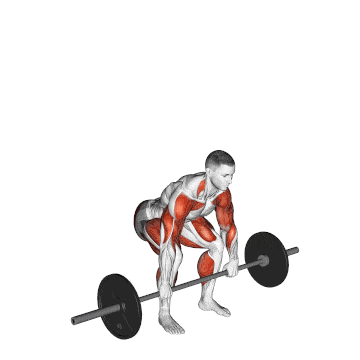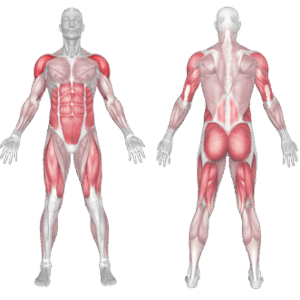Overview
The clean and jerk is one of the two main lifts in Olympic weightlifting competitions. It is a highly technical, full-body exercise that trains explosive power, coordination, balance, and strength. The lift consists of two phases: the clean, where the barbell is lifted from the ground to the shoulders, and the jerk, where it is driven overhead. The clean recruits the posterior chain for a powerful pull and hip extension, while the jerk emphasizes upper-body strength and speed for the overhead drive. Mastering this movement requires mobility, timing, and progressive training.
How to perform Clean and Jerk

Set up with feet hip-width apart, barbell over mid-foot, and hands slightly wider than shoulder-width.
Clean Phase:
Keep the back flat and chest up as you lift the bar from the ground.
Explosively extend through the hips and shrug, pulling the bar upward.
Drop under the bar and catch it in a front rack position with elbows high.
Jerk Phase:
Dip slightly by bending the knees, then drive upward through the legs.
Split or push under the bar quickly, locking out the arms overhead.
Stabilize and stand upright to complete the lift.
Tips for Proper Form
Keep your back tight during the initial pull to avoid rounding.
Drive through the heels and extend the hips fully before the catch.
Practice front rack mobility to support a secure clean position.
Use a controlled dip and aggressive drive in the jerk phase.
Catch the bar with a solid base, especially in the split jerk.
Common Mistakes
Pulling too early, which reduces bar height and disrupts timing.
Not extending the hips fully before dropping under the bar.
Poor front rack position, leading to instability in the clean.
Rushing the jerk, without a proper dip and drive sequence.
Failing to stabilize overhead, especially under fatigue.
Benefits of the Clean and Jerk
Builds Explosive Strength: Trains power output through rapid hip extension and overhead drive.
Develops Total-Body Coordination: Requires synchronization of the lower and upper body across two phases.
Improves Athletic Performance: Enhances speed, balance, and timing for sport-specific movement.
Increases Mobility and Flexibility: Demands dynamic mobility in the ankles, hips, shoulders, and wrists.
Boosts Functional Strength: Trains real-world movement patterns and strength under load.
Enhances Core Stability: Requires trunk control in both the front rack and overhead positions.
Effective for Conditioning: When performed in complexes, it provides a high metabolic challenge.
How to Incorporate Into Your Routine
- For Beginners: Start with drills like the hang clean and push press, using light weight and proper progression.
- For Strength and Power: Perform 3–5 sets of 2–3 reps at 70–90 percent of your 1RM, with full recovery between sets.
- For Functional Training: Include as part of an athletic power program, paired with plyometrics or speed drills.
- For Circuit Training: Use lighter loads for 3–4 rounds in a metabolic conditioning circuit.
- For General Fitness: Practice as a skill lift 1–2 times per week to improve movement quality and strength.
- For Olympic Lifters: Program clean and jerk days with accessory lifts like jerks from blocks, front squats, and clean pulls.
Clean and Jerk Muscles Worked

Frequently Asked Questions
Is the clean and jerk safe for beginners?
Yes, if taught progressively with proper coaching and scaled loads.
What’s the difference between a push jerk and a split jerk?
The push jerk uses a shallow dip under the bar with feet together, while the split jerk uses a wider base for better balance under heavy loads.
How much weight should I start with?
Start light to master form—often just a technique bar or PVC pipe—before increasing load.
Do I need to do both the clean and the jerk together?
Not always. Each phase can be trained separately to improve mechanics and strength.
What type of athletes benefit from this lift?
All athletes. It develops power, mobility, and control for performance across many sports.
